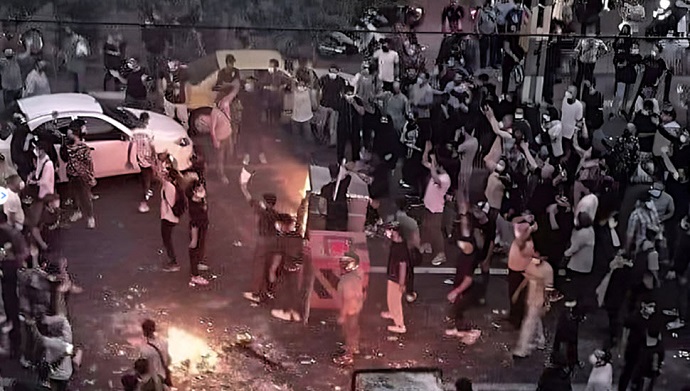The nationwide uprising in Iran is entering its sixth week on Friday, marking the 36th day of the ongoing anti-regime protests.
Protests in Iran have to this day expanded to 193 cities. Over 400 people have been killed, and more than 20,000 are arrested by the regime’s forces, according to sources of the Iranian opposition People’s Mojahedin Organization of Iran (PMOI/MEK). The names of 224 killed protesters have been published by the PMOI/MEK.
On Friday, the people of Zahedan held anti-regime protests after the Friday prayers, despite heavy security measures. The people of the city held a large gathering and chanted slogans against the regime. This protest rally comes weeks after the regime carried out a brutal massacre in Zahedan, in which security forces killed at least 90 civilians—including several children—and injured more than 300 in what became known as “Zahedan’s bloody Friday.”
October 21 – Zahedan, southeast #Iran
Locals continuing the nationwide protests against the regime with a large rally on the 36th day of the uprising.#IranRevolution2022#آزادی_آزادی_آزادیpic.twitter.com/zg7Ebhi8OQ— People's Mojahedin Organization of Iran (PMOI/MEK) (@Mojahedineng) October 21, 2022
Protesters took to the streets on Friday night in several cities, including Tehran, Tabriz, Mahabad, Piranshahr, Isfahan, Kermanshah, Ilam, and others, holding protest rallies and establishing roadblocks to take control of their streets.
Early Friday morning, various protesters in Sanandaj and other cities attacked sites associated with the regime’s security forces, including bases of the Revolutionary Guards (IRGC) paramilitary Basij Force. Locals in Tabriz and Mahabad were seen gathering in their city streets, starting fires, and establishing roadblocks to gain control of their areas and prevent the regime from dispatching its security forces. Similar rallies were also reported in Isfahan, central Iran.
Friday morning in Mashhad, northeast Iran, Medical personnel rallied outside the city’s Medical Council and chanted anti-regime slogans, including “Death to the dictator!” and “We don’t want a child-killing government!” The staff also chanted “Death to the dictator!” in Friday’s Medical Council session, specifically targeting regime Supreme Leader Ali Khamenei.
Merchants in the city of Firuzabad in Fars Province went on strike and closed their shops in solidarity with the ongoing anti-regime uprising across the country.
In an exclusive revelation made by the Iranian opposition coalition National Council of Resistance of Iran (NCRI), IRGC chief Hossein Salami has issued specific instructions to the IRGC and Basij Force to “refrain from deploying demoralized, disaffected, and disgruntled personnel in riot control operations and prevent their participation in calming operations.” This sheds light on the growing dilemmas the regime faces as the nationwide uprising, including defections in their own ranks and files.
“In light of the violent actions and assaults carried out to take over the Basij centers, allocate the necessary capabilities for added protection of weapons, ammunition, and equipment in these canters and undertake the needed measures to secure them,” Salami added in his instructions.
Mohammad Sadegh Kushki, a former interrogator of the regime’s Ministry of Intelligence and Security, offered an analysis of the ongoing protests across Iran. “In my opinion, the riots and events of the last few weeks that we have witnessed in our country have a ‘central core’ and an ‘external layer.’ All kinds of people can be found in the external layer of these developments and disturbances. The central core is formed by the young generation of our country. In my opinion, this generation is suffering from abnormality,” he said in an interview with the semi-official ILNA on October 20.
“This generation is like a powder keg that has been ignited by other currents. However, it also has the ability to explode and rebel against everything, including even family bonds. In this regard, around this central core, we have, of course, witnessed the existence of terrorist groups such as the Komeleh, the Kurdistan Democratic Party, and the MEK. However, as I said, the central core is an abnormal group and generation,” Kushki explained.
These protests began following the death of Mahsa Amini. Mahsa (Zhina) Amini, a 22-year-old woman from the city of Saqqez in Kurdistan Province, western Iran, who traveled to Tehran with her family, was arrested on Tuesday, September 13, at the entry of Haqqani Highway by the regime’s so-called “Guidance Patrol” and transferred to the “Moral Security” agency.
She was brutally beaten by the morality police and died of her wounds
in a Tehran hospital on September 16. The event triggered protests that quickly spread across Iran and rekindled the people’s desire to overthrow the regime.





